Noosa, Queensland 作者: 来源: 发布时间:2021-03-25
I. Population and Area
Total Area: 40 km²
Population: 3, 999
https://www.weather-forecast.com/locations/Noosa-Heads/forecasts/latest
II. Natural Geography
-Climate
The ideal climate for a beachside holiday destination, Noosa's weather is characterised by mild temperatures and sunny days. Water temperatures are fairly stable for most of the year too, so no matter what time you choose to visit Noosa, you can enjoy its stunning beaches. The tropical climate and warm weather of Noosa are ideal for exploring the local activities and attractions, indulging in some shopping and fine dining or simply sitting back and relaxing around the pool.
Summer in Noosa is from December to February with the hottest time of year in January. Average daily temperatures range from a minimum of 21.3ºC to a maximum of 28.8 ºC. January to March is also the wettest with high humidity (peaking at around 66 per cent in the afternoons) causing the occasional shower.
March, April and May are the autumn (fall) months and continue to enjoy warm weather and surprisingly humid conditions, particularly in the mornings when humidity can park at around 74 per cent. Although temperatures are slightly cooler, the weather is definitely still warm enough to swim.
Winter falls from June to August and although these are the coldest months Noosa experiences, conditions are still relatively temperate, ranging from a minimum of 10.2 ºC up to a comfortable 20.9 ºC. With the skies clearing, winter is the perfect time to warm up and sun yourself on the beach.
For September to November, Spring is the perfect time to visit Noosa as the chance of rain is minimal but the sunshine is plentiful. The lowest average annual rainfall, spring brings clear skies, warm temperatures and the perfect weather for enjoying the beaches and national parks.
With comfortable weather year round, the tropical climate of Noosa ensures that no matter the weather, the extended forecast for Noosa is for a fantastic holiday.
https://www.travelonline.com/noosa/weather
Noosa has the ideal weather for a beachside holiday destination which is part of what makes it so popular. Noosa weather enjoys plenty of sunny days and typically mild temperatures. In fact, with water temperatures remaining fairly stable throughout the year, it doesn't matter when you choose to visit Noosa, you can still enjoy all the gorgeous beaches it has to offer. Noosa's warm weather and tropical climate makes it ideal for exploring local attractions and activities, enjoying a long leisurely lunch, shopping up a storm or just kicking back by the pool.
December to February is summer in Noosa, with January being the hottest month. During this time of year daytime temperatures average between 21C minimum to 29C maximum. January to March is also the wettest and most humid time of year with occasional showers and afternoon humidity peaking at around 66 per cent.
March to May is autumn (fall) in Noosa, with the weather remaining warm and the humidity increasing. Mornings in particular can be surprisingly humid, with a peak of approximately 75 per cent. Although temperatures tend to start cooling off around this time, the weather is still definitely warm enough to enjoy a swim.
June to August is winter in Noosa and although these are Noosa's coldest months, conditions are still fairly mild. Temperatures range from a crisp minimum of around 10C reaching a comfortable 21C during the day. Noosa is still a popular place to visit during winter as the skies clear up, making it the perfect place to sun yourself and warm up on the beach.
September to November is spring in Noosa and this is perhaps the most popular time to visit. Sunshine is plentiful, temperatures are very pleasant and the chance of rain is very minimal. In fact, these months experience the lowest annual average rainfall and bring clear skies and warm temperatures - perfect weather for making the most of the national parks and beaches.
http://www.noosa-heads.net/weather/
The climate of Noosa is similar to that experienced in nearby Brisbane, in that it is categorised as being 'humid subtropical'. Being located within the Southern Hemisphere, the seasons and weather in Noosa fall at different times of the year, with spring starting in September, and summer in December.
Temperatures in Noosa remain pleasant throughout the year, although the climate in December and January is noticeably warmer, when daytime temperatures regularly exceed 30°C / 86°F. However, do expect some humidity at this time of the year, as well as an increased likelihood of rainy weather and thunderstorms. Average monthly precipitation levels are around 115 mm / 4.5 inches in the summer, while July is reliably the driest month, with less than 30 mm / 1.2 inches of rainfall.
http://www.world-guides.com/australia-continent/australia/queensland/noosa/noosa_weather.html
-Geography
Noosa: Australia’s sunshine playground
Noosa may have become Australia’s answer to the Hamptons, but this once sleepy seaside haven has still got soul, says Lucy Brook.
Boasting balmy waters and unspoiled green expanses, including Noosa National Park, where koalas laze in towering gum trees and native bush turkeys scuttle across the boardwalk, this stretch of Queensland’s Sunshine Coast is lauded as one of Australia’s most outstanding areas of natural beauty. I’ve been coming here for 22 years and, while I still love it, I’ve seen it change from laid-back surfer’s secret to international jetsetter’s playground.
This once-sleepy seaside haven, 90 minutes’ drive from Brisbane, has seen a spate of luxury resorts, trendy boutiques and hip eateries, not to mention glossy editorials in the likes of Vogue and Condé Nast Traveler. As a result, the area has acquired a very different image. Noosa is now being heralded as Australia’s answer to the Hamptons. I’m here to explore just how appropriate – and welcome – the new tag is.
“It’s definitely evolved,” says Tim Crabtree, who runs surf business Noosa Longboards and opened Noosa’s first boutique brewery, Land and Sea, in January. Five years ago, we’d have really big highs through summer and really big slumps in winter. In the last two or three years, those lows have filled in. It’s never quiet any more.”
Crabtree, 38, has lived in Noosa for 10 years. He thinks its natural beauty coupled with the allure of Hastings Street – the town’s chic shopping and dining zone – makes comparisons with the Hamptons inevitable. “Noosa has always had an influx of affluent people from the cities because it’s an off-the-beaten-track paradise,” he says. “It’s an incredible part of the world.”
Noosa first became du jour when the 1980s development of Hastings Street – which runs parallel to Main Beach – brought fine-dining, five-star resorts and posh boutiques to the town, beginning the transformation. The aim, first, was to attract well-heeled weekend visitors from Sydney, but in recent times, a more international celebrity crowd has clocked it as a hotspot too; guests have included everyone from Mick Jagger to Prince Harry.
You might think this sounds like a classic story of an unspoilt location ruined by the arrival of mass tourism, but Noosa is different. As the tourists descended, Noosa’s small, eco-friendly mentality persisted, and its radical anti-development efforts, population caps and relentless environmental activism have made it what it is today: both a glamorous seaside village and a vast, ecological wonderland. “In other words,” says Noosa’s Mayor Tony Wellington with a chuckle, “modern Noosa has been fought for, repeatedly.”
Since the early 1960s, the community has weathered attempts to turn Noosa into a version of Queensland’s Gold Coast, known for its glitzy nightclubs, theme parks and sprawl of skyscrapers. In 1962, local doctor Arthur Harrold rallied a group of concerned residents and formed the Noosa Parks Association. They lobbied tirelessly against the development of Noosa Headland – now Noosa National Park – which was at risk of being razed to make way for a main road. With its serene coastal walking tracks and sweeping vistas, Noosa National Park is now one of the most visited in Australia. The battles continued through the 80s and 90s, when the local council routinely rejected what they deemed “inappropriate development”. Building heights were restricted to four storeys, public signage was kept to a minimum and roundabouts were installed in lieu of traffic lights. Today, close to half the shire is protected from any human development. “The aim was always to retain a village feel,” says Wellington.
At its heart, Noosa is still a typical Aussie surf village, albeit one with growing international appeal. Until my late twenties, when I moved from Brisbane to the Northern Hemisphere, I spent great chunks of every summer in Noosa, and was always beguiled by its easy, sand-in-your-hair lifestyle. However, by the early 2000s, Hastings Street had begun to feel stale: the restaurants, shops and hotels seemed tired and out of touch with younger generations. But massive visitor slumps after the financial crisis in 2008 and relentless rain through the high seasons of 2011 and 2012 seemed to rouse Noosa’s fighting spirit and kickstart a rebirth.
Leading the way was Makepeace Island, which opened in July 2011. The luxurious private hideaway, built on a tiny, heart-shaped island just upstream on the Noosa River, came complete with its own koala sanctuary and rekindled international interest in the region. In 2013, the five-star Sheraton Resort, which rebranded as the Noosa Sofitel in 2016, swapped 80s kitsch for contemporary beach chic with an AU$10m (US$7.8m) makeover, and Seahaven Resort on Main Beach followed suit, reopening in late 2013 after an AU$16m (US$12.6m) renovation. 10 Hastings, a buzzy boutique hotel and cafe, opened the same year, and new retailers, boutiques and eateries moved in, bringing a fresh creative spirit and innovative energy.
Now, when I go back every year, I’m struck by Noosa’s evolution. Fine-dining establishments sit alongside casual, eat-in-your-bathers options. Hastings Street is dotted with hip fashion, design and interiors boutiques. The hotel scene has ushered in a new kind of beach chic, and trendy boutique hotels and home-away-from-home options have mushroomed.
“The strip has really changed,” says Graeme Connor, director of Hastings Street’s luxurious Tingirana Resort. It recently closed for a four-month refurbishment, reopening in September 2017 with elegant interiors and the tagline, “A touch of the Hamptons in laid-back, Noosa style”. “It’s still got high-end options in terms of food and accommodation,” says Connor, “but now it’s catering for everyone.”
https://atlas.etihad.com/sunshine-playground-noosa-australia/
-Transportation
Planning your ride from the Sunshine Coast to the Sunshine Coast Airport (MCY) can be difficult, but this Sunshine Coast Airport departure transfer makes it easy. End your trip on a good note, and ride this climate-controlled, comfortable transfer from your hotel to the airport. This transport service will pick you up anywhere on the Sunshine Coast, from Caloundra to Noosa. Save time with this Sunshine Coast Airport departure transfer 1-way transfer service is perfect for busy travelers on the go Get picked up at your Sunshine Coast hotel, and arrive at the Sunshine Coast Airport Driver even helps you carry your luggage to the vehicle.
Read more about Sunshine Coast Airport Departure Transfer from Hotels 2020 - Noosa & Sunshine Coast.
Public Transport
Give public transport a go
Public transport is a convenient and sustainable way to get around Noosa. Bus services in Noosa are operated by Sunbus on behalf of TransLink, a division of the Department of Transport and Main Roads. TransLink are responsible for setting bus routes and the location of bus stops.
Bus and train
To help you identify which services you can access, view the Sunshine Coast Region Network Map. For bus and train timetable and service options use the TransLink journey planner or call TransLink on 13 12 30 anytime.
Taxis
One taxi company operates in Noosa: Suncoast Cabs phone 131 008.
Suncoast Cabs are also the contracted operator for delivery of the following council transport services:
Boreen Point to Tewantin Flexilink service
Council Cabs - for over sixties and people with a disability
Bus stops
To find your nearest bus stop visit the TransLink website. Once you have entered your location, your nearest bus stops will be identified, together with a list of routes servicing the stops.
For more information on Noosa Council's role in public transport please review the following Council reports:
Public Passenger Transport - Legislation
Public Passenger (Urban Bus) Transport Network Review
https://www.noosa.qld.gov.au/community/transport-and-roads/transport/public-transport
Noosa Heads is the tourist heart of Noosa district, with many restaurants and hotels. The main street is Hastings Street, which lies directly behind the seashore. Buses to elsewhere in the Sunshine Coast depart from Noosa Heads bus station.
There are dedicated bike lanes throughout the shire. Push bikes are an easy way to get around. Bike racks are provided in all shopping and beach precincts.
Motor scooter is another easy option. There are scooter parking bays on Hastings Street, Noosa Heads, and on many shopping strips.
There is a taxi rank in Hastings Street and at Noosa Fair shopping centre.
https://kids.kiddle.co/Noosa_Heads,_Queensland
III. Economy

https://quickstats.censusdata.abs.gov.au/census_services/getproduct/census/2016/quickstat/SED30065
IV. Industrial Characteristics
Noosa's beauty, weather and enviable lifestyle make it one of Australia's most desirable places to live, work and visit.
Noosa's economy relies significantly on the health, professional service, tourism, retail and construction sectors. It is home to almost 7000 businesses, predominately small and micro, as well as successful entrepreneurs and skilled business people.
The Noosa Shire Local Economic Plan, was developed in consultation with the local community and aims to broaden the structure of the Noosa economy through growth in smart industry sectors that offer high economic value and have low environmental impact.
https://www.noosa.qld.gov.au/business/economic-development
The Local Economic Plan for Noosa has been developed through a process of consultation and engagement with the community and guided by a Project Focus Group.
The Local Economic Plan looks to support the development of:
A more diverse local economy
Growth in smart industry sectors
A smart approach to planning
Sustainability - the interdependence of the economy, the environment and the community.
It also:
provides a policy statement that is easily understood and clearly explains the philosophy behind why we do what we do;
is realistic, achievable and sufficiently resourced;
is capable of evolving, and spans a 5 year time frame;
is market driven;
clearly expresses Council’s role which includes facilitating, enabling, connecting, partnering and direct delivery;
recognises innovation as a key driver of business growth;
values education and a skilled and talented workforce and business community;
recognises and maximises benefits from its Noosa Biosphere® status and;
demonstrates best use of available resources.
https://www.noosa.qld.gov.au/business/economic-development/local-economic-plan
Business Profile
Noosa, Good for Business explores the business environment in Noosa & the many advantages the location provides. View the Noosa, Good for the Business flip book or download the Noosa, Good for Business(PDF).
Industry Profile
A Taste for Noosa looks at the rural enterprise, primarily food and beverage. Noosa is well known for its passionate local food culture its reputation for culinary clout food and award-winning restaurants and producers. View A Taste of Noosa flip book or download A Taste of Noosa (PDF).
Cracking the Code In Noosa explores the Digital Sector, its people, networks and opportunities that are driving this emerging sector. View Cracking the Code in Noosa flip book or download Cracking the Code in Noosa (PDF).
Knowledge Investment in Noosa highlights the pathways to education, training and lifestyle that Noosa offers and the opportunity as a quality education destination. View Knowledge Investment in Noosa flip book or download the Knowledge Investment in Noosa (PDF).
https://www.noosa.qld.gov.au/business/why-choose-noosa/business-industry-profiles
In the Noosa Shire Council area, Accommodation and Food Services had the largest total exports by industry, generating $282 million in 2018/19.
Exports by industry are sales of goods and services to non-resident households, businesses and other organisations, outside the Noosa Shire Council area boundaries. Exports (domestic) include all exports from the area to other parts of Australia. Exports (international) includes all exports from the Region to countries outside Australia.
To get the full picture how each industry sector contributes to the regional or state economy, export data should be viewed alongside the other industry characteristics in the Industry sector analysis section.
Detailed notes about how the figures are derived can be found in the specific topic notes section.
https://economy.id.com.au/noosa/exports-by-industry
In the Noosa Shire Council area, Manufacturing had the largest total imports by industry, generating $796 million in 2018/19.
Imports by industry are sales of goods and services from industries located outside the Noosa Shire Council area Plains boundaries to resident households, businesses and other organisations within the area. Imports (domestic) includes all imports from other parts of Australia to the Region.Imports (international) includes the value of all imports to the area from outside Australia.
To get the full picture how each industry sector contributes to the regional or state economy, import data should be viewed alongside the other industry characteristics in the Industry sector analysis section.
Detailed notes about how the figures are derived can be found in the specific topic notes section.
https://economy.id.com.au/noosa/imports-by-industry
Key Projects:
12. Noosa
The Noosa River oyster reef restoration trial is the first shellfish restoration project installed in Queensland. The project seeks to restore the structurally complex oyster reefs that were once abundant in the Noosa River, thereby enhancing habitat availability for fish species of commercial and recreational fishing significance.
Results to date have demonstrated that the trial reefs attract 1.4 times the number of fish species and 1.8 times the number of harvestable fish than nearby control sites. Similarly, we found significant oyster growth, with over 300 oysters/m2 growing on the reefs. These results will be used to educate the design and placement of oyster reefs in a second phase of restoration in the Noosa River in 2019.
The Noosa River oyster reef restoration trial is a collaboration between the University of the Sunshine Coast, Noosa Biosphere Reserve Foundation, Noosa Council, Noosa Parks Association, The Nature Conservancy, Ecological Service Professionals and The Thomas Foundation.
Oyster reefs were restored at 14 sites in the Noosa River in November 2017
Restoration sites were selected according to 7 key criteria:
Within the historical distribution of oyster reefs
Spread risk (floods, erosion, vandalism)
No interference with marine plants (according to marine plants legislation)
Low risk to navigation and public safety
Low recreation displacement (jetskis, boating)
Provide stepping stones for fish to move throughout the estuary
Maximise seascape connectivity (i.e. proximity to different alternative habitat types, esp. mangroves, seagrass, deep channels)
https://www.noosaoysterreefs.org/
V. Attractions
True to its name, the Sunshine Coast, in South East Queensland, basks in year-round sunshine, and its mild, subtropical climate and squeaky-clean beaches make it one of the state's most popular tourist destinations.
A quieter alternative to the glitzy Gold Coast farther south, the Sunshine Coast stretches north from the popular beaches of Caloundra to the sweeping sands of Noosa North Shore, where 4WD vehicles plow a wild stretch of dune-backed beach.
Sunshine Coast destinations are packed with things to do. You can feast on fresh-caught seafood at buzzing Mooloolaba Beach, look for snoozy koalas in the national parks, hike to the summit of Mount Coolum, surf some of the country's best breaks, or shop for designer clothes on Noosa's chic Hastings Street.
Families will find plenty of fun attractions to keep the kids entertained, including Underwater World, the Ginger Factory, and the famous Australia Zoo.
Not far from the coast's glamorous beaches, the emerald-hued hinterland offers its own sleepy charm. Top things to do in the Sunshine Coast hinterland include exploring quaint mountain villages, tasting artisan foods, and browsing the colorful markets.
Plan your sightseeing in this beautiful region with our list of the top tourist attractions in the Sunshine Coast.
1. Noosa National Park
Noosa National Park is one of the Sunshine Coast's natural jewels. The park encompasses more than 9,800 acres of paperbark forests, pristine beaches, rainforest, dunes, and heathlands.
The most popular section of the park is the Noosa Headland section, with 15 kilometers of hiking trails, including a scenic coastal track that offers a great introduction to the park for first-time visitors. Hiking this trail is one of the best things to do on the Sunshine Coast for free. Before you set out, stop by the information center near the entrance at the end of Park Road and check for recent animal sightings.
Along the coastal track, you'll see spectacular sea views framed by eucalyptus, banksia, and spiraling pandanus trees. Look up every now and then, and you might spot a koala snoozing in the crook of a tree or a glossy black cockatoo.
After about a kilometer, a lookout at Dolphin Point offers panoramic coastal views and sometimes even glimpses of whales and dolphins. Tea Tree Bay or Granite Bay are the perfect spots for a picnic or a paddle in the rock pools. Continuing even farther, Hell's Gates offers breathtaking views of pounding surf and Alexandria Bay.
If you're feeling energetic, you can also hike to the park entrance from Noosa Main Beach. The coastal track is accessible for wheelchairs and strollers all the way to Dolphin Point. Bring sunscreen and plenty of water.
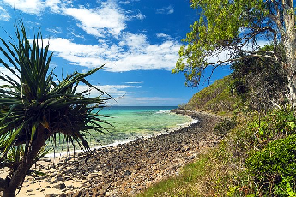
2. Australia Zoo, Beerwah
About 22 kilometers west of Caloundra, Australia Zoo is one of Queensland's most popular attractions. Steve Irwin, the late croc-loving Aussie conservationist, and his wife Terri helped the park grow into a world-class attraction on 110 acres, with a strong emphasis on conservation and education.
The zoo provides plenty of fun encounters with Aussie animals, including kangaroos, koalas, snakes, and lizards, as well as a striking lineup of exotic species such as elephants, rhinos, cheetahs, and the crowd favorite- Sumatran tigers.
While you're here, try to attend one of the popular live animal shows in the Crocoseum. Depending on the schedule, you can see everything from croc-feeding demonstrations and birds of prey to otters and koalas.
Kids will love hand-feeding kangaroos and giraffes, petting koalas, and riding camels. For an additional fee, you can also visit the animal hospital and support their healing work.
A visit to Australia Zoo is usually a full day adventure. Wear your walking shoes, and be sure to bring sun protection, a refillable water bottle, and a rain jacket-sudden downpours can strike at any time.
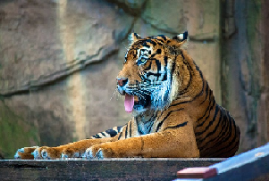
3. Noosa Main Beach and Hastings Street
Squeaky-clean sands and glistening surf breaks lure both visitors and locals alike to the glorious stretch of north-facing coast at Noosa Main Beach. The gentle surf makes it a popular hangout for families and beginner surfers, and it's a lovely spot for a swim, with beautiful views of Noosa National Park cloaking the headland at the eastern end of the beach.
Noosa Main Beach is patrolled every day of the year and is safe for swimming year-round. If you have little ones in tow, the sandy bays along the Noosa River are only five minutes away by car and are the perfect place for a paddle, a picnic, or to cast a fishing line.
If you need a break from the Aussie sun, Hastings Street, Noosa's main drag, is only a short stroll away with chic designer shops, restaurants, and art galleries.
Other popular beaches on the Sunshine Coast include nearby Sunshine Beach; Peregian Beach; busy Mooloolaba Beach; and Coolum Beach, with its popular beachside boardwalk. Kings Beach in Caloundra is also a favorite; kids love the fun water fountain and beachfront swimming pool.
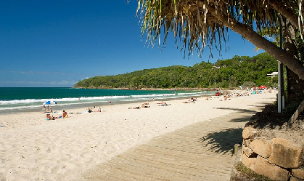
4. The Original Eumundi Markets
About 20 kilometers southwest of Noosa, the Original Eumundi Markets are the perfect place to soak up some local color. The markets are held every Wednesday morning and Saturday in the cute hinterland town of Eumundi.
Artisan foods, organic produce, designer clothes, home goods, plants, jewelry, skincare, natural therapies, and toys are just some of the items on offer. This is a fantastic place to buy Sunshine Coast souvenirs or enjoy lunch from one of the food stalls, which sell everything from Thai food to Turkish kebabs.
Fun kids' activities, such as camel rides, complement the fabulous shopping. Roving performers keep everyone entertained, and the kids can burn off steam at the playground adjacent to the market.
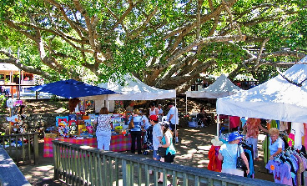
5. The Charming Mountain Villages of Montville and Maleny
For a change in scenery from the coast's sun-splashed beaches, you can take a scenic drive across the Blackall Range through the picturesque hinterland to the cute mountain villages of Montville and Maleny.
These quaint sister towns lie a little more than 10 minutes' drive away from each other, but most tourists visit them both on a day trip from the coast, where the temperatures can often be a little cooler, thanks to the higher elevations. The drive is part of the Blackall Range Tourist Drive and offers spectacular views of the plunging valleys below.
In Montville, art galleries, gift shops, boutiques, and cozy cafés huddle along the tree-lined streets, and you'll notice some European-inspired architecture.
Maleny is also an artsy town, with many galleries, studios, and workshops. Its nearby attractions include Maleny Botanic Gardens & Bird World, with a miniature animal enclosure, aviary, and Devonshire tea; and Maleny Dairies, where you can milk a cow, pet farm animals, and taste some creamy yogurts and cheeses after the tour.
Other Sunshine Coast hinterland tourist attractions include beautiful Kondalilla Falls near Montville, and wildlife lovers can look for pademelons and fruit bats on the trails in the Mary Cairncross Scenic Reserve near Maleny, which offers gorgeous views of the Glass House Mountains.
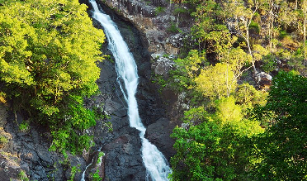
6. Glass House Mountains National Park
Popular with nature lovers and hikers, the distinctive peaks of Glass House Mountains National Park are listed on the Queensland and National Heritage Register. The area is also one of the spiritual places on the Sunshine Coast for the Gubbi Gubbi people, who used this site for sacred ceremonies, as well as trading.
According to aboriginal legend, Mount Beerwah, the highest peak, is the mother that gave birth to the smaller surrounding peaks, and Mount Tibrogargan is the father peak. Rising like giant witch's hats and rounded anthills, the peaks are volcanic plugs, the center of extinct volcanoes.
Mount Ngungun and Mount Tibrogargan are the only two peaks open to the public for hiking, and they offer trails catering to all abilities, from easy base trails to more challenging summit hikes with spectacular coastal views.
Abseiling, mountain biking, horseback riding, and rock climbing are other popular things to do, and the park is home to a rich diversity of plant and animal life, including koalas, echidnas, and grey kangaroos.
Before exploring the area, stop by the Glass House Mountains Visitor and Interpretative Centre. The popular Lookout Cafe, near the Glass House Mountains lookout, is a lovely spot to start or end a gentle hike with Devonshire tea and delightful views. Keep an eye out for kangaroos under the mango trees here.
Address: Glass House Interpretative Centre, Settler's Rotary Park, Reed Street, Glass House Mountains
Official site: http://www.nprsr.qld.gov.au/parks/glass-house-mountains/
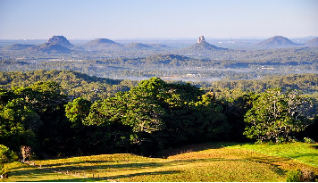
7. Noosa North Shore and Rainbow Beach
The gateway to World Heritage-listed Fraser Island, Noosa North Shore is an 80-kilometer stretch of powdery, white sand and gently rolling dunes just across the river from Noosa Heads and Noosaville. This seemingly endless stretch of beach is especially popular with 4WD enthusiasts, anglers, and beachfront campers, who come here for the stunning sea vistas and typically uncrowded stretches of sand.
Wildlife is prolific around the camping areas, and you might see kangaroos, goannas, and rainbow lorikeets. When the tides are low, you can drive along the beach past Teewah and the Colored Sands, ochre-hued cliffs, until you reach Rainbow Beach and Double Island Point, where the car ferry departs for Fraser Island.
You can access Noosa North Shore on the daily car ferry from the end of Moorindil Street in Tewantin. Note that vehicle permits are required to drive along the beach and on some of the inland tracks.
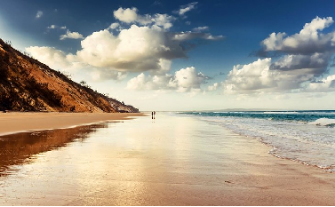
8. Mooloolaba Beach
Bristling with high-rise apartments, Mooloolaba Beach is more developed than other Sunshine Coast beaches, but that's part of its popularity. Surf shops, boutiques, galleries, organic eateries, and restaurants beckon just across the street from this sun-drenched north-facing stretch of sand, offering plenty of opportunities to refuel and take a break from the sun.
Popular things to do on the beach include surfing, swimming, sunbathing, and strolling along the beachfront promenade. If you're feeling energetic you can walk all the way to Mooloolaba Spit, about a 40-minute hike, where calmer waters lap the shores, and fishing boats bring in their catches. You can even dive one of Australia's best wrecks, the HMAS Brisbane, off the coast.
Not far from Mooloolaba Beach is Underwater World Sea Life, a popular family attraction, as is nearby Alexandra Headland with a patrolled beach, great point break, and popular skatepark.
Just north of Mooloolaba in Marcoola is the Sunshine Coast Airport, with frequent flights from destinations around Australia, and if you're pining for a shopping fix, head to Sunshine Plaza, the largest outdoor shopping mall on the Sunshine Coast. Browsing the shops here is one of the most popular things to do in Maroochydore.
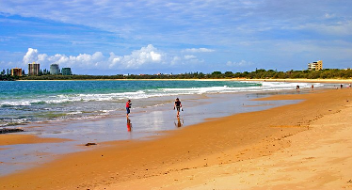
9. Coolum Beach
The coastal town of Coolum Beach is a popular base for Sunshine Coast tourists, thanks to its beautiful stretch of shoreline and plentiful holiday apartments.
Surfing, in particular, is a favorite pastime, and many beginners take lessons at the surf schools here. Locals and tourists alike stroll along the boardwalk and gather by the beach for picnics.
Across the street from the beach are a string of health-food cafés and restaurants, where you can stock up on picnic items or enjoy a casual lunch.
The most distinctive landmark in the area is Mount Coolum, a dome-shaped volcanic rock rising 208 meters above the coast. Fitness enthusiasts and nature lovers hike the 800-meter track to the summit for breathtaking views of the coast. It takes about 30-40 minutes and is best tackled in dry weather, as the steep rocks at the top become slippery after rain.
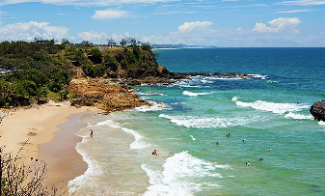
https://www.planetware.com/australia/sunshine-coast-aus-qld-sc.htm
VI. History and Culture
The Noosa River and lakes were flooded by sea during the glacial period 130,000 years ago making Noosa Heads into an island. The mountains in the area were formed by volcanic lava thrust upward that have withstood erosion over millions of years whilst the softer land around washed away and created the Great Sandy Park with its high dunes.
It is speculated that the name “Noosa” is derived from the Aboriginal “noothera” or “gnuthuru” meaning shade or shadow. The first visitors to Noosa, the Gubbi Gubbi people roamed the area in bark canoes living off the abundant riches provided by the river system. The Gubbi Gubbi was a well planned matrilineal society with the woman’s name being given to the land and the tribe.
Tewantin’s first permanent resident Grainger Ward settled in 1870 and by 1912 Tewantin had developed into a thriving town with four hotels, shops and a regular coach service to Gympie. The early wealth was created by timber and milling with a regular paddle steamer the Culgoa making three trips a fortnight delivering timber to Brisbane until being wrecked on the Noosa Bar on 13th May 1891.
Noosa tourism developed in the late 1920’s. The Noosa Surf Life Saving Club began in 1927 as a tent on the beach and now a major building on the beach offering wonderful views, food and service.
Over the years many battles have taken place between the demands of the developer against those that wanted to protect this unique and wonderful coastal community. Nancy Cato, in her book The Noosa Story first published in 1979 provides a gripping story of the battles that were fought, won and lost. Nancy sadly died in 2000 and is remembered in a memorial park named after her on Noosa Parade. More recently Michael Gloster in his beautifully illustrated book The Shaping of Noosa published in 1997 carries on the story.
The 70’s saw developers working hand in hand with a local council and business desperate to exploit the pristine parcels of land that boarded the coastline. It was also the start of what has been a continuing migration of people from southern states and overseas attracted to the Noosa lifestyle. A capture of Noosa Council during 1982 – 1985 by a strong pro conservation group started a process of change, and a desire to preserve “paradise”. Battles have taken place over extensive development of the North Shore with planned jet airport and resorts, building on Noosa Hill and currently a fierce and vocal debate over the planned Noosa Shire Business Centre.
Today, Noosa led by Mayor Bob Abbott, a conservation minded community, the benefits of being surrounded by National Parks and council purchased protected areas has become a success story for excellence in town planning and provision of highly desired lifestyles. Some argue that Noosa represents the world’s most perfect town, a cry not just made by locals but recognised in press stories appearing around the world.
Noosa’s dependence on tourism is gradually decreasing with the growth of intellectually based business managed by “barefooted executives” making full use of the new telecommunication technologies and the skills within the community. Noosa tourism still remains the major industry and developers are still building noosa holiday accommodation for the visitors that are coming to Noosa from all over Australia and the world.
A population cap of 50,000, no high rise development permitted and very limited land available for development should protect Noosa for future generations to enjoy. It also leads to some of the fastest rising property prices in Australia, creating a vibrant real estate business, which can be viewed on the futuristic video screen displays in the Tom Offermann Real Estate office on Hastings Street.
http://www.noosaeguide.com/noosa_information_history.php
Noosa has a high-end culture, but you’ve also got beautiful beaches, amazing scenery and a laid-back lifestyle.
The Lodge Noosa Heads – a three-bedroom house purchased and renovated by stylist Sjan Johansen in 2016 – has also brought Hamptons-esque interiors to the holiday rental landscape, while nearby haunts such as Ivory Palms Resort have tapped the family market. Luxury hideaway retreats, like Makepeace Island and Peppers Noosa Resort & Villas, which is tucked away in the national park, cater for couples and those wanting to immerse themselves in nature. “The international market has picked up big time,” explains Connor. “Noosa’s appeal,” he says, “has become so much broader.”
When I arrive in Noosa, I always make a beeline for breakfast at 10 Hastings before my next, crucial stop. Coffee is a draw for most Australians, and there’s stiff competition for Noosa’s top drop. Along Hastings Street, Aromas and Cafe Le Monde are among the best, while newcomer Providore on Hastings, below the iconic Netanya Resort, has also got the goods, and uses locally roasted Little Cove beans. When breakfast and coffee have been ticked off the to-dos, most folks hit the water. As well as easy, year-round swimming – water temperatures range from 19ºC in winter to 25ºC in summer – Noosa offers spectacular surfing.
“The waves are some of the best longboard waves in the world when it’s doing its thing,” says Thomas Bexon, a lifelong local whose eponymous surfboard company custom-makes boards for clients around the globe. “There’s not many places in the world with five sand-bottom point breaks in a row running around a headland. The geography makes it really unique.”
Non-surfers needn’t fret, there’s plenty to do that doesn’t involve a longboard. Accessible from Main Beach, the Noosa National Park walk is one of the most beautiful coastal trails in the world. Follow it past Little Cove along to Tea Tree Bay, Dolphin Point and Granite Bay. The full coastal walk, which is 10.8km there and back, winds down through Alexandria Bay all the way to Sunshine Beach. The park also boasts a vast network of forest tracks, home to native koalas, wallabies and kookaburras. Keep your eyes peeled for dolphins, turtles and stingrays in the azure water below.
For a freshwater adventure, board the MV Catalina. The 20-year-old boat, stationed on the Noosa River, was luxuriously refurbished in late 2015 and hosts floating Friday night socials, Saturday lunches and Sunday breakfasts. Further afield, Eumundi Markets – a 20-minute drive away – is a lively Sunshine Coast institution, open every Wednesday and Saturday. Whether I’ve surfed, shopped or flopped, I always have lunch at Betty’s Burgers. Opened in 2013 on a Hastings Street plot that was vacant for years, it’s one of Noosa’s favourite haunts. Queues down the street are commonplace, a phenomenon 38-year-old owner David Hales attributes to the restaurant’s relaxed, alfresco setting, anything-goes dress code and top-secret sauce recipes.
But it’s at night that the place really comes to life. If I’m in the mood for an aperitif, I pop into Miss Moneypenny’s, a chichi cocktail bar which was also part of Noosa’s new wave, before heading to Bistro C for dinner. At this long-time favourite, perched on Main Beach since 1991, head chef Dayle Merlo’s passion for local produce is evident in dishes such as his calamari served with chilli, lime and coriander dipping sauce. For dessert, an oversized scoop of gelato from Massimo’s is a Noosa rite of passage (don’t let the queue deter you, it moves fast). Rare rainy days are an opportunity to indulge in some of Noosa’s new luxuries: browse the gorgeous wares in Signature on Hastings, an interior design shop stocked with everything for the contemporary beach house, get a fashion fix at designer boutique Bowery 475, or book a treatment at Sensaura Day Spa.
While Noosa’s overhaul has cemented its status as a must-visit destination for the international jet set, locals insist it’s still a place for slowing down and embracing simple pleasures. “A perfect day in Noosa is getting up early and making the most of the coastal lifestyle, whether it’s surfing, swimming or watching the sunrise,” says Tim Crabtree. “Noosa certainly has a high-end, sophisticated culture, but there’s so much more to it. It’s not just Hastings Street, you’ve got beautiful beaches, amazing scenery, an extraordinary river and lake system and a laid-back lifestyle.”
Local surfer and author Mike Davis has the perfect phrase to sum up Noosa: “the place where God kissed the planet”. In other words: Paradise.
https://atlas.etihad.com/sunshine-playground-noosa-australia/
Surf
Many surf schools operate in the area
Merrick's Learn to Surf 0418 787 577. Two hour lessons take place twice a day for $55. They get almost everyone standing up on the first lesson and are Noosa's only licensed surf school. Classes 9AM and 1.30PM daily. Private lessons available at 11.15AM for $140.
WaveSense [14] Classes from 10 till 12 and 2 till 4 for $55
Kite Surfing
Noosa is one of the best Kite Surfing destinations in the world, as the prevailing wind directions are almost always favourable.
Australian Kitesurfing Academy - Martin Reeves IKO senior instructor and Codie Stephenson IKO level 2 conduct lessons 20mins north of Noosa at Lake Cootharaba. AKA has been training since 2001 on the Sunshine Coast and offers lessons where the student is in the water within 30mins of kite setup. Quality assured and fully insured. one2one student/instructor radio communication at all times. www.kitesurfingaustralia.com.au www.noosakitesurfing.com
Noosa Kite Surfing Lessons Mike Burrell from Noosa Kiteboarding conducts one on one Kite surfing lessons, catering to all levels of experience.
https://wikitravel.org/wiki/en/index.php?title=Noosa
Noosa Heads' main attraction is its beaches. Its main beach and its small bays around the headland are common surfing locations which are known on world surfing circuits. One of its major surfing contests involves the Noosa Festival of Surfing. This festival attracts large numbers of longboarders. A fatal shark attack of a 22-year-old surfer was recorded at Noosa in 1961.
https://kids.kiddle.co/Noosa_Heads,_Queensland
VII. Contact Information
Mayor Clare Stewart
Phone: 07 5329 6100
Email: clare.stewart@noosa.qld.gov.au
Deputy Mayor
Cr Frank Wilkie
Phone: 07 5329 6103
PO Box 141
Tewantin QLD 4565
Phone: (07) 5329 6500
Email: mail@noosa.qld.gov.au
https://www.noosa.qld.gov.au/about-council/councillors-meetings/mayor-and-councillors
